-
Legacy Member

Chamber shoulder and case shoulder gauge for .303?
I'm not inquiring about a Headspace gauge, I'm inquiring about a gauge that looks at the dimension to the shoulder of the chamber and to the shoulder of the the case. Has such ever been made?
There was formerly a Stoney Pointe case gauge, now something similar made by Hornady, which would appear to work for measuring where the shoulder is, but I am looking for a steel gauge.
CDD 
Information
 |
Warning: This is a relatively older thread
This discussion is older than 360 days. Some information contained in it may no longer be current. |
|
-
-
04-05-2009 10:12 AM
# ADS
Friends and Sponsors

-
Advisory Panel


I'm unsure exactly what you're looking for, but measuring a normal fired case will give the bolt face to shoulder dimension of the chamber (plus any action stretch). Nothing fancy is required - a 9mm pistol case works about as well as anything if we're looking for comparative rather than absolute dimensions. A more durable version can be made from a 1" section of 1/2" steel rod bored with an inside diameter appropriate to the cartridge neck and shoulder - but will not yield results visibly different when using a .001" caliper.
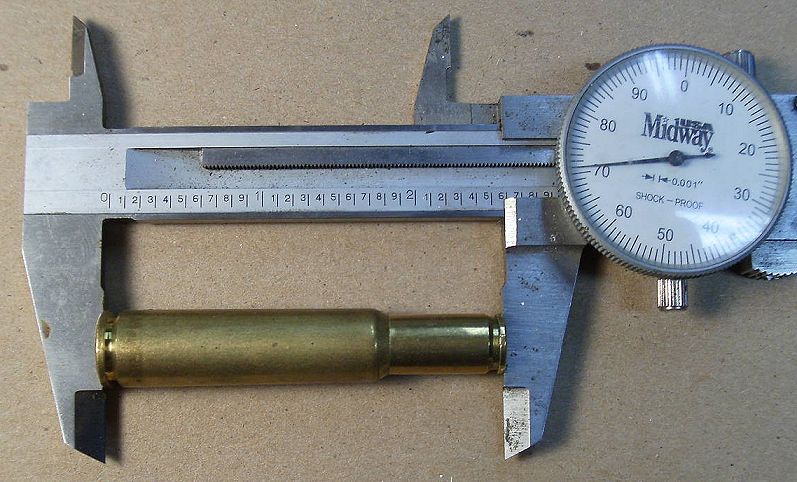
Use the same setup on a sized case to see what change has occurred during sizing. Or compare fired cases from two rifles to measure any difference in the face-shoulder dimension. A similar arrangement can be used to measure differences in action stretch at varying pressures, but it may take a good .0001", 3" jaw micrometer to register the small amounts involved.
-
-
Legacy Member

Nobody ever worried too much about it; the rim, they thought, took care of most of the problems this would have caused with a rimless case. Of course they did have to increase the dimensions in WW1, to take care of dirty or indifferently made ammunition. Reloading, of course, was not considered (nor should it have been).
-
-
FREE MEMBER
NO Posting or PM's Allowed

Some folks believe that they can obtain the best accuracy if the case fits the chamber tightly in addition to the headspace being tight. I can see that it might be true, but have never seen any solid data to show that it is. If anyone has, I am sure the folks here would appreciate seeing it.
From a purely functional viewpoint, of course, the position of the case shoulder in a rimmed case like the .303 or the .30-30 is pretty much irrelevant as long as it doesn't interfere with chambering.
Jim
-
Banned

Yes they are called “Wilson Case Gauge BUT they are for a SAAMI commercial chamber BUT they tell an interesting story, the cases rest on the shoulder for gauging purposes.
Below is the Wilson gauge with a new unfired Remington .303 case inside the gauge, as you can see Remington and Winchester do NOT know where to put the shoulder of the case and the case is a ¼ inch below where it should be.
The gauge has a slight groove milled in the top and bottom, the top represents min & max headspace and the bottom groove is min & max case length

Next is a fired case in the gauge and now it is sticking above the top of the gauge, this represents how far the military chamber was reamed and lengthened to allow for dirt and mud in the chamber. The gauge is still usable with a vernier caliper but the milled groove for head space can not be used.
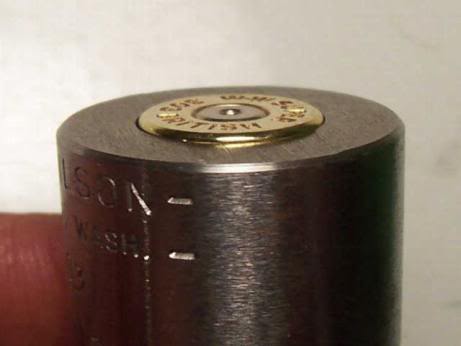
Below in the top photo is a South African PMP surplus please note that they know where to put the shoulder of the case, this case is perfectly made and is .002 below the min headspace line on the gauge.
NOTE: the American Remington and Winchester cases average .058 on rim thickness on the cases I have, the South African PMP .303 has a rim thickness of .062 again .002 below minimum headspace as it should be.
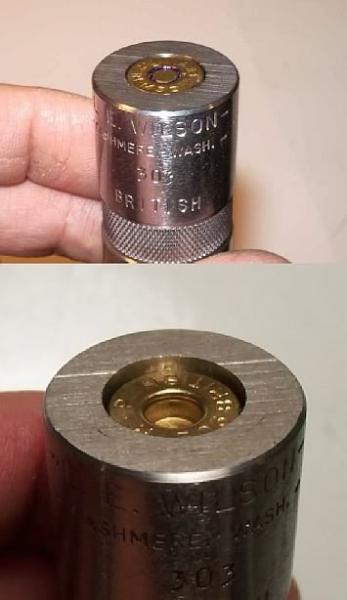
Our American made .303 cases leave a lot to be desired, the are designed for a lower pressure than military standard which is approximately 45,000 CUP, our American ammunition is loaded to pressures lower than 43,000 CUP due to the older No.1 or SMLE still being used and shot (lawsuits) and these cases do not stand up well during reloading.
On the other hand Prvi Partizan cases are some of the best commercially made cases that can be used for reloading, they have thicker rims and larger base diameters than our American cases do.


Below base diameters of the Privi and Greek HXP cases, this is just one reason I give the Privi cases high marks.
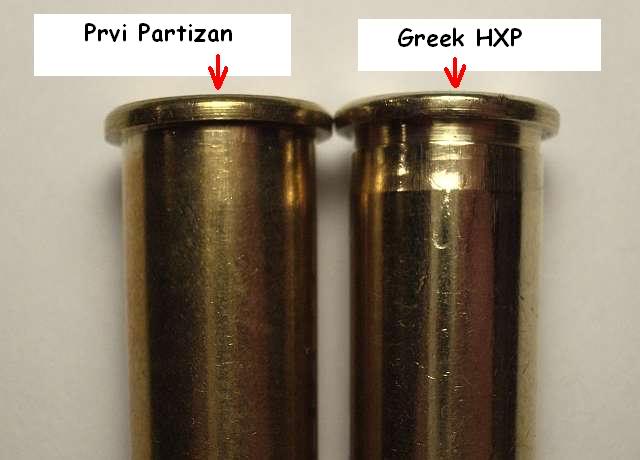
Last edited by Edward Horton; 04-05-2009 at 11:12 PM.
-
FREE MEMBER
NO Posting or PM's Allowed

I dont have data. But I can say that it sure helps the .303 Enfields that I have to just neck size, cuts group size down alot.
Cary
-
Legacy Member

[QUOTE=Edward Horton;35120]“Wilson Case Gauge"
Mr Horton:
That is precisely what I want.  I've been all over the internet, and I can't find that. Can you point me to where I can get one?
I've been all over the internet, and I can't find that. Can you point me to where I can get one?
I'm doing a study of relative elastic movement in actions on firing. I want to study those that are regarded as moving a bit, those that move some, and those that don't move much. I have ordered a Hornady tool already to measure cases from shoulder datum line to rear of case head, and I'd like to have case gauges and gauges to measure the distance from a datum point on the shoulder of the chamber to the boltface. I've been trying to figure out where I could put a strain gauge to get direct measurement, and can't see a place that will give me meaningful info.
CDD
-
-
Banned

L.E.Wilson is an old name in precision reloading equipment, and RCBS also makes the precision mic which reads like a micrometer.
L.E. Wilson Inc. Wilson Tools and Gages
http://www.lewilson.com/images/2009_...Mini_Final.pdf
MidwayUSA - L.E. Wilson Cartridge Headspace Gage 303 British
http://www.midwayusa.com/viewproduct...tnumber=574297
The average commercial cartridge is .002 smaller or shorter than minimum headspace, the RCBS Precision Mic allows you to measure cartridge headspace before and after shooting the cartridge to set up your reloading dies.

Also Savage and Stevens makes rifles that you can easily adjust headspace on with a simple barrel nut wrench, you can get the Stevens 200 for under $200.00.

-
Banned

If you want to make you actions flex MORE just put a little grease or oil in the chamber BUT this is hard on the action and increases bolt thrust which in turn unduly pounds the heck out of your action and increases headspace.


-
Banned


Originally Posted by
Jim K

Some folks believe that they can obtain the best accuracy if the case fits the chamber tightly in addition to the headspace being tight. I can see that it might be true, but have never seen any solid data to show that it is. If anyone has, I am sure the folks here would appreciate seeing it.
From a purely functional viewpoint, of course, the position of the case shoulder in a rimmed case like the .303 or the .30-30 is pretty much irrelevant as long as it doesn't interfere with chambering.
Jim
Jim K
Headspace is governed by the cartridge cases you shoot and not the rifle, the .303 British is a perfect example, commercial cases can be stretched beyond their design limits in the Enfield chamber and self destruct in just a few reloadings.
is a perfect example, commercial cases can be stretched beyond their design limits in the Enfield chamber and self destruct in just a few reloadings.
On the other hand a rifle with a tight chamber and tight headspace settings will strain the cartridge case far less.
If I remember correctly cartridge cases are made from five different grades or specifications of brass and American .303 cases are one or two grades below what would be used in the upper pressure category as in the .308 Winchester and above.
I was taught the finer aspects of reloading by a benchrest shooter and machinist and benchrest shooters like tight chambers for preserving their brass and accuracy.
By my standards a 30-30 has a loose chamber and longish headspace, I stopped counting how many times I have reloaded my 30-30 cases 20 years ago, on the other hand three reloadings from a Winchester case in the .303 is extremely short lived.
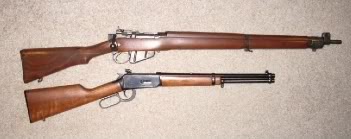
It boils down to chamber diameter and headspace and chamber pressure for case longevity, with long life going to the tight chamber.
My bottom line here is the Enfield Rifle gets blamed for our poorly made American .303 cases which the factory downloads to a lower pressure to avoid law suits, I believe these American made cases are made from brass in the 30-30 and 30-40 class or spec.
gets blamed for our poorly made American .303 cases which the factory downloads to a lower pressure to avoid law suits, I believe these American made cases are made from brass in the 30-30 and 30-40 class or spec.
This book tells you to set your headspace .003 over your rim thickness, on my Remington and Winchester cases the rim thickness averages .058, this puts your headspace at .061.
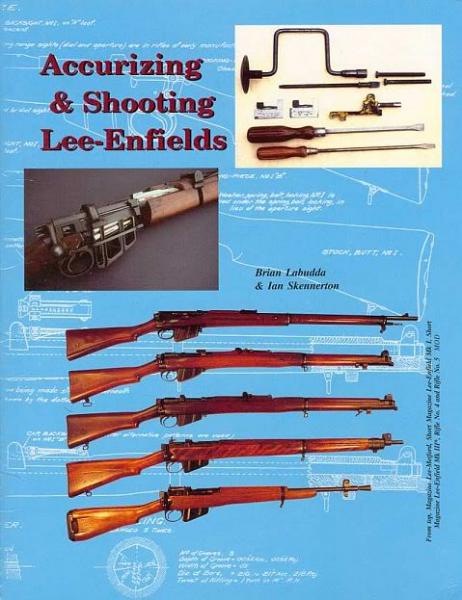
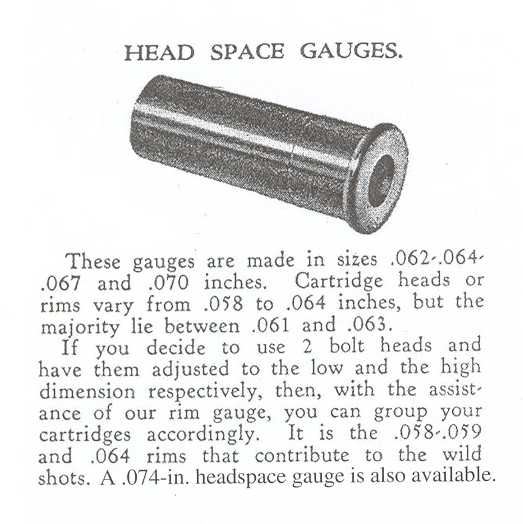
 Information
Information














 PM
PM












 I've been all over the internet, and I can't find that. Can you point me to where I can get one?
I've been all over the internet, and I can't find that. Can you point me to where I can get one?





